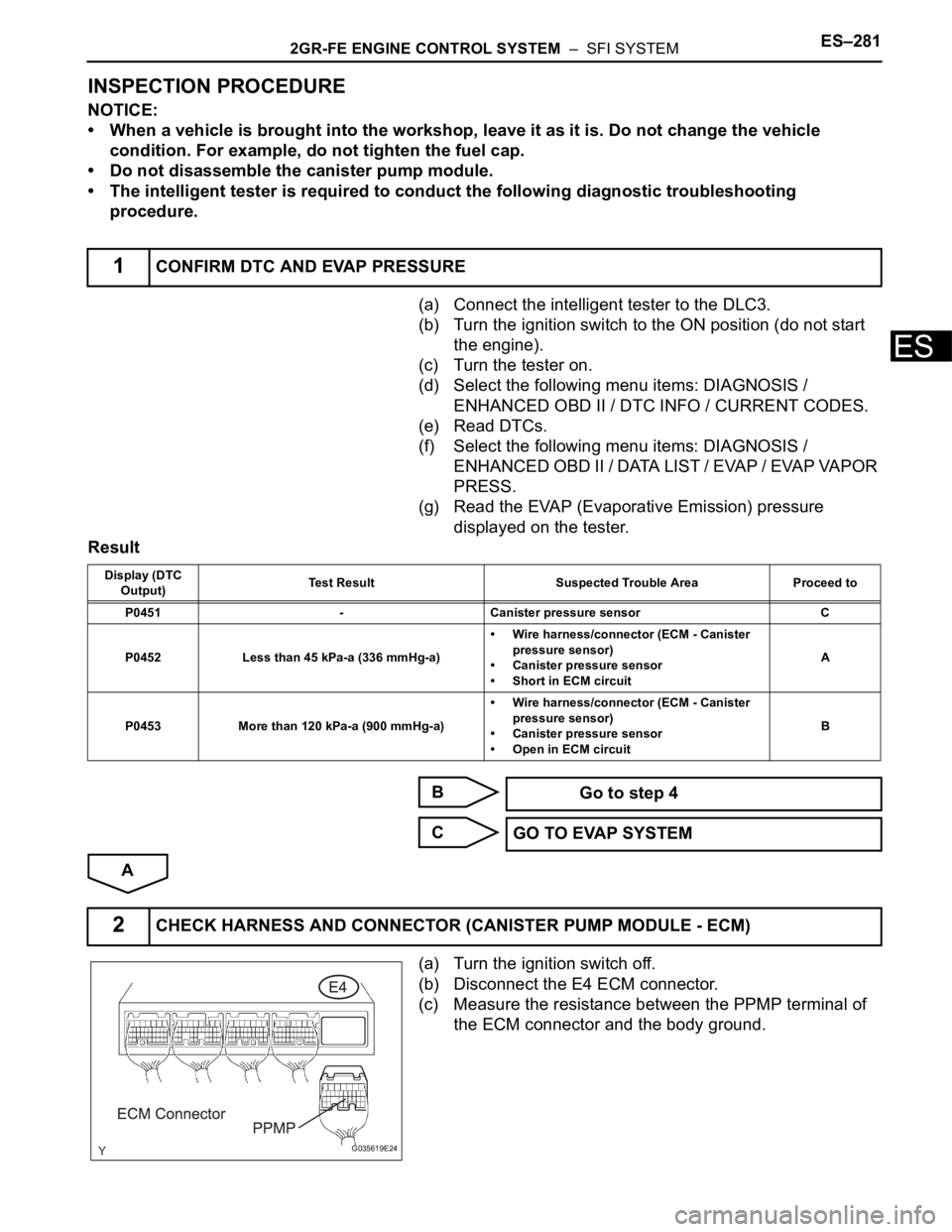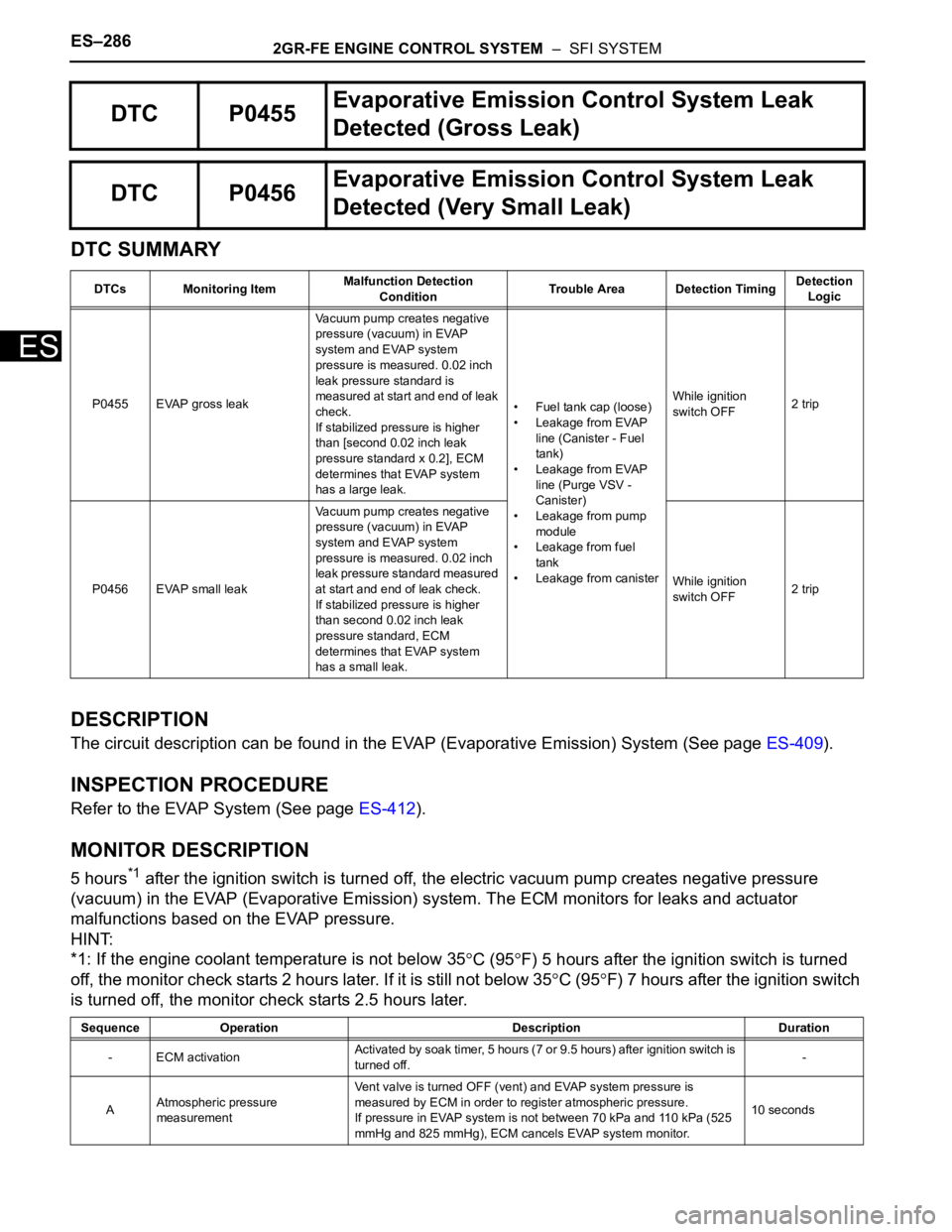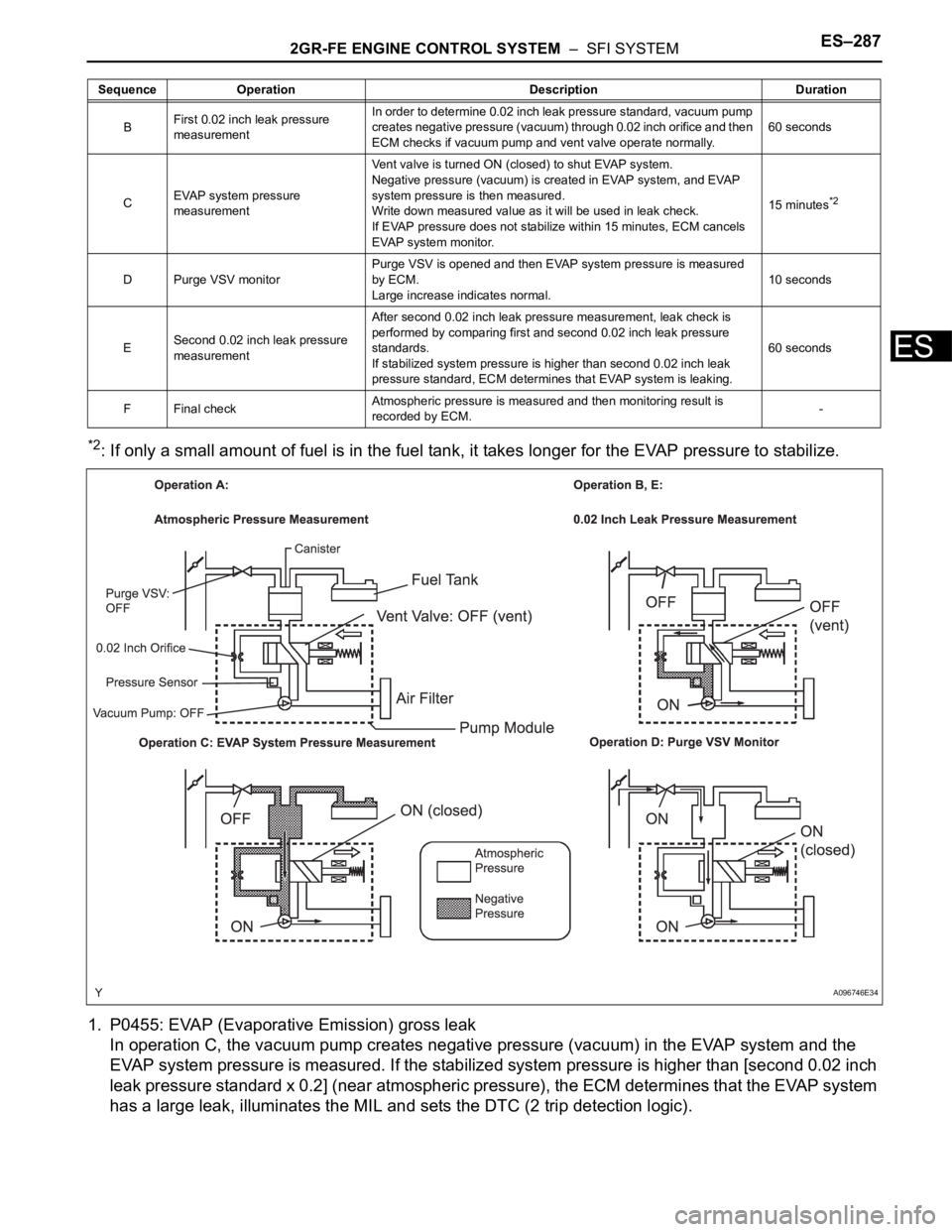Page 569 of 3000

ES–2762GR-FE ENGINE CONTROL SYSTEM – SFI SYSTEM
ES
2. First reference pressure measurement
3. EVAP canister vent valve close stuck check
4. Vacuum introduction
5. EVAP canister purge valve close stuck check
6. Second reference pressure measurement
7. Leak check
8. Atmospheric pressure measurement
TYPICAL MALFUNCTION THRESHOLDS
Purge flow:
EVAP VSV stuck open:
EVAP VSV stuck closed:
MONITOR RESULT
Refer to CHECKING MONITOR STATUS (See page ES-19).
Next sequence is run if the following conditions are met Conditions 1, 2 and 3
1. EVAP pressure just after reference pressure
measurement-1 kPa (-7.5 mmHg) or less
2. Reference pressure -4.85 to -1.057 kPa (-36.384 to -7.929 mmHg)
3. Reference pressure Saturated within 1 minute
Next sequence is run if the following condition is met -
EVAP pressure change after vent valve is ON 0.3 kPa (2.25 mmHg) or more
Next sequence is run if the following condition is met -
EVAP pressure Saturated within 15 minutes
Next sequence is run if the following condition is met -
EVAP pressure change after purge valve is open 0.3 kPa (2.25 mmHg) or more
Next sequence is run if the following conditions are met Conditions 1, 2, 3 and 4
1. EVAP pressure just after reference pressure
measurement-1 kPa (-7.5 mmHg) or less
2. Reference pressure -4.85 to -1.057 kPa (-36.384 to -7.929 mmHg)
3. Reference pressure Saturated
4. Difference between first reference pressure and
second reference pressureLess than 0.7 kPa (5.25 mmHg)
Next sequence is run if the following condition is met -
EVAP pressure when vacuum introduction was
completeLower than second reference pressure
EVAP monitor is complete if the following condition is
met-
Atmospheric pressure difference between sequence 1
and 8Within 0.3 kPa (2.25 mmHg)
Both of the following conditions are met Conditions (a) and (b)
(a) EVAP pressure change when purge flow is started Less than 0.1 kPa (0.75 mmHg)
(b) EVAP pressure change during purge flow when
EVAP pressure switching valve ON (closed)Less than 0.5 kPa (3.75 mmHg)
EVAP pressure when vacuum introduction is complete Higher than reference pressure x 0.2
EVAP pressure change after EVAP canister purge
valve is openLess than 0.3 kPa (2.25 mmHg)
Page 574 of 3000

2GR-FE ENGINE CONTROL SYSTEM – SFI SYSTEMES–281
ES
INSPECTION PROCEDURE
NOTICE:
• When a vehicle is brought into the workshop, leave it as it is. Do not change the vehicle
condition. For example, do not tighten the fuel cap.
• Do not disassemble the canister pump module.
• The intelligent tester is required to conduct the following diagnostic troubleshooting
procedure.
(a) Connect the intelligent tester to the DLC3.
(b) Turn the ignition switch to the ON position (do not start
the engine).
(c) Turn the tester on.
(d) Select the following menu items: DIAGNOSIS /
ENHANCED OBD II / DTC INFO / CURRENT CODES.
(e) Read DTCs.
(f) Select the following menu items: DIAGNOSIS /
ENHANCED OBD II / DATA LIST / EVAP / EVAP VAPOR
PRESS.
(g) Read the EVAP (Evaporative Emission) pressure
displayed on the tester.
Result
B
C
A
(a) Turn the ignition switch off.
(b) Disconnect the E4 ECM connector.
(c) Measure the resistance between the PPMP terminal of
the ECM connector and the body ground.
1CONFIRM DTC AND EVAP PRESSURE
Display (DTC
Output)Test Result Suspected Trouble Area Proceed to
P0451 - Canister pressure sensor C
P0452 Less than 45 kPa-a (336 mmHg-a)• Wire harness/connector (ECM - Canister
pressure sensor)
• Canister pressure sensor
• Short in ECM circuitA
P0453 More than 120 kPa-a (900 mmHg-a)• Wire harness/connector (ECM - Canister
pressure sensor)
• Canister pressure sensor
• Open in ECM circuitB
Go to step 4
GO TO EVAP SYSTEM
2CHECK HARNESS AND CONNECTOR (CANISTER PUMP MODULE - ECM)
G035619E24
Page 575 of 3000
ES–2822GR-FE ENGINE CONTROL SYSTEM – SFI SYSTEM
ES
Result
(d) Reconnect the ECM connector.
B
A
(a) Disconnect the C27 canister pump module connector.
(b) Disconnect the E4 ECM connector.
(c) Measure the resistance between the PPMP terminal of
the ECM connector and the body ground.
Result
(d) Reconnect the canister pump module connector.
(e) Reconnect the ECM connector.
A
Test Result Suspected Trouble Area Proceed to
10
or less• Wire harness/connector (ECM - Canister pressure
sensor)
• Short in canister pressure sensor circuitA
10 k
or more• Wire harness/connector (ECM - Canister pressure
sensor)
• Short in ECM circuitB
Go to step 7
3CHECK HARNESS AND CONNECTOR (CANISTER PUMP MODULE - ECM)
A165550E01
Test Result Suspected Trouble Area Proceed to
10 k
or more Short in canister pressure sensor circuit A
10
or lessShort in wire harness/connector (ECM - Canister
pressure sensor)B
Go to step 5
Page 576 of 3000
2GR-FE ENGINE CONTROL SYSTEM – SFI SYSTEMES–283
ES
B
(a) Disconnect the C27 canister pump module connector.
(b) Turn the ignition switch to the ON position.
(c) Measure the voltage and resistance of the canister
connector.
Standard
Result
(d) Reconnect the canister pump module connector.
A
B
(a) Replace the canister assembly (See page EC-8). Go to step 6
4CHECK HARNESS AND CONNECTOR (CANISTER PUMP MODULE - ECM)
A165552E01
Tester Connection Specified Condition
C27-4 - Body ground 4.5 to 5.5 V
C27-3 - Body ground 4.5 to 5.5 V
C27-2 - Body ground 100
or less
Test Result Suspected Trouble Area Proceed to
Voltage and resistance within standard ranges Open in canister pressure sensor circuit A
Voltage and resistance outside standard rangesOpen in wire harness/connector (ECM - Canister
pressure sensor)B
Go to step 5
Go to step 6
5REPLACE CHARCOAL CANISTER ASSEMBLY
Page 577 of 3000
ES–2842GR-FE ENGINE CONTROL SYSTEM – SFI SYSTEM
ES
NOTICE:
When replacing the canister, check the canister
pump module interior and related pipes for water,
fuel and other liquids. If liquids are present, check
for disconnections and/or cracks in the following: 1)
the pipe from the air inlet port to the canister pump
module; 2) the canister filter; and 3) the fuel tank
vent hose.
NEXT
HINT:
If the exhaust tailpipe has been removed, go to the next step
before reinstalling it.
NEXT
(a) Replace the ECM (See page ES-498).
NEXT
A163294E01
Go to step 8
6REPAIR OR REPLACE HARNESS OR CONNECTOR (CANISTER PUMP MODULE - ECM)
Go to step 8
7REPLACE ECM
Go to step 8
Page 578 of 3000
2GR-FE ENGINE CONTROL SYSTEM – SFI SYSTEMES–285
ES
(a) Connect the intelligent tester to the DLC3.
(b) Turn the ignition switch to the ON position and turn the
tester on.
(c) Wait for at least 60 seconds.
(d) On the tester, select the following menu items:
DIAGNOSIS / ENHANCED OBD II / DTC INFO /
PENDING CODES.
HINT:
If no pending DTCs are displayed on the tester, the
repair has been successfully completed.
NEXT
8CHECK WHETHER DTC OUTPUT RECURS (AFTER REPAIR)
COMPLETED
Page 579 of 3000

ES–2862GR-FE ENGINE CONTROL SYSTEM – SFI SYSTEM
ES
DTC SUMMARY
DESCRIPTION
The circuit description can be found in the EVAP (Evaporative Emission) System (See page ES-409).
INSPECTION PROCEDURE
Refer to the EVAP System (See page ES-412).
MONITOR DESCRIPTION
5 hours*1 after the ignition switch is turned off, the electric vacuum pump creates negative pressure
(vacuum) in the EVAP (Evaporative Emission) system. The ECM monitors for leaks and actuator
malfunctions based on the EVAP pressure.
HINT:
*1: If the engine coolant temperature is not below 35
C (95F) 5 hours after the ignition switch is turned
off, the monitor check starts 2 hours later. If it is still not below 35
C (95F) 7 hours after the ignition switch
is turned off, the monitor check starts 2.5 hours later.
DTC P0455Evaporative Emission Control System Leak
Detected (Gross Leak)
DTC P0456Evaporative Emission Control System Leak
Detected (Very Small Leak)
DTCs Monitoring ItemMalfunction Detection
ConditionTrouble Area Detection TimingDetection
Logic
P0455 EVAP gross leakVacuum pump creates negative
pressure (vacuum) in EVAP
system and EVAP system
pressure is measured. 0.02 inch
leak pressure standard is
measured at start and end of leak
check.
If stabilized pressure is higher
than [second 0.02 inch leak
pressure standard x 0.2], ECM
determines that EVAP system
has a large leak.• Fuel tank cap (loose)
• Leakage from EVAP
line (Canister - Fuel
tank)
• Leakage from EVAP
line (Purge VSV -
Canister)
• Leakage from pump
module
• Leakage from fuel
tank
• Leakage from canisterWhile ignition
switch OFF2 trip
P0456 EVAP small leakVacuum pump creates negative
pressure (vacuum) in EVAP
system and EVAP system
pressure is measured. 0.02 inch
leak pressure standard measured
at start and end of leak check.
If stabilized pressure is higher
than second 0.02 inch leak
pressure standard, ECM
determines that EVAP system
has a small leak.While ignition
switch OFF2 trip
Sequence Operation Description Duration
- ECM activationActivated by soak timer, 5 hours (7 or 9.5 hours) after ignition switch is
turned off.-
AAtmospheric pressure
measurementVent valve is turned OFF (vent) and EVAP system pressure is
measured by ECM in order to register atmospheric pressure.
If pressure in EVAP system is not between 70 kPa and 110 kPa (525
mmHg and 825 mmHg), ECM cancels EVAP system monitor.10 seconds
Page 580 of 3000

2GR-FE ENGINE CONTROL SYSTEM – SFI SYSTEMES–287
ES
*2: If only a small amount of fuel is in the fuel tank, it takes longer for the EVAP pressure to stabilize.
1. P0455: EVAP (Evaporative Emission) gross leak
In operation C, the vacuum pump creates negative pressure (vacuum) in the EVAP system and the
EVAP system pressure is measured. If the stabilized system pressure is higher than [second 0.02 inch
leak pressure standard x 0.2] (near atmospheric pressure), the ECM determines that the EVAP system
has a large leak, illuminates the MIL and sets the DTC (2 trip detection logic).
BFirst 0.02 inch leak pressure
measurementIn order to determine 0.02 inch leak pressure standard, vacuum pump
creates negative pressure (vacuum) through 0.02 inch orifice and then
ECM checks if vacuum pump and vent valve operate normally.60 seconds
CEVAP system pressure
measurementVent valve is turned ON (closed) to shut EVAP system.
Negative pressure (vacuum) is created in EVAP system, and EVAP
system pressure is then measured.
Write down measured value as it will be used in leak check.
If EVAP pressure does not stabilize within 15 minutes, ECM cancels
EVAP system monitor.15 minutes
*2
D Purge VSV monitorPurge VSV is opened and then EVAP system pressure is measured
by ECM.
Large increase indicates normal.10 seconds
ESecond 0.02 inch leak pressure
measurementAfter second 0.02 inch leak pressure measurement, leak check is
performed by comparing first and second 0.02 inch leak pressure
standards.
If stabilized system pressure is higher than second 0.02 inch leak
pressure standard, ECM determines that EVAP system is leaking.60 seconds
F Final checkAtmospheric pressure is measured and then monitoring result is
recorded by ECM.- Sequence Operation Description Duration
A096746E34